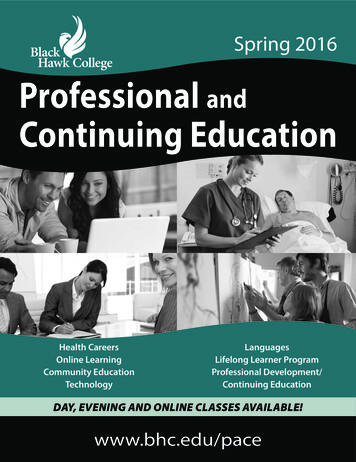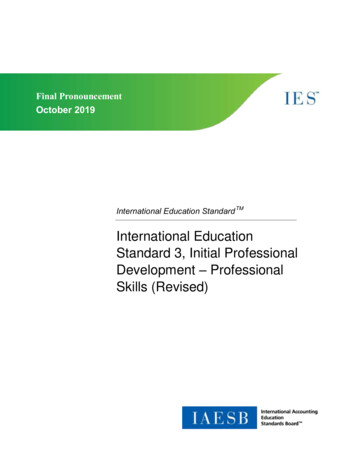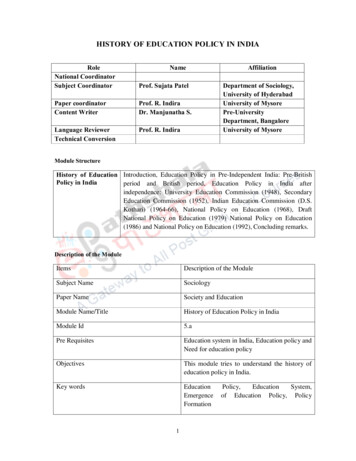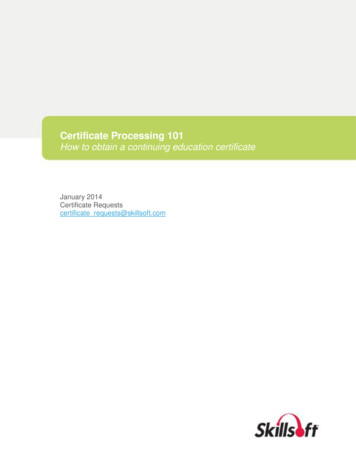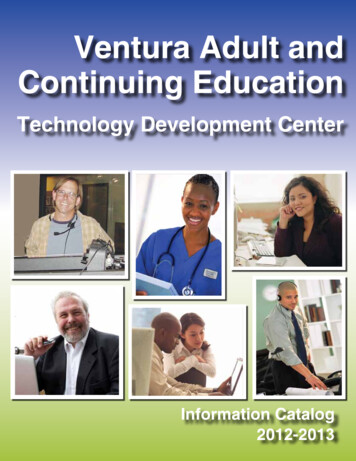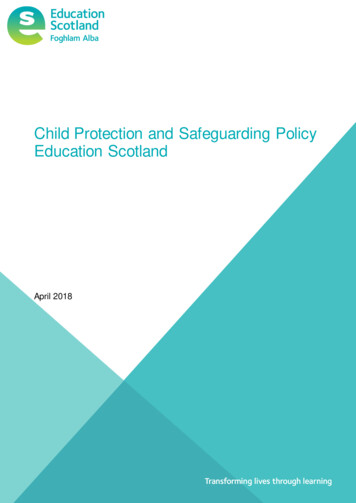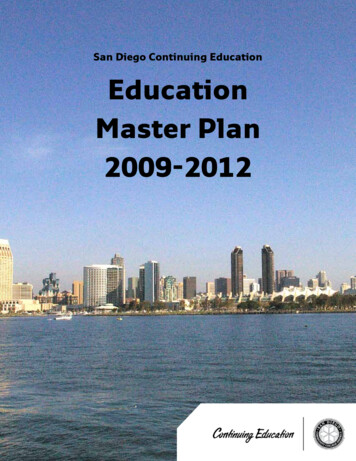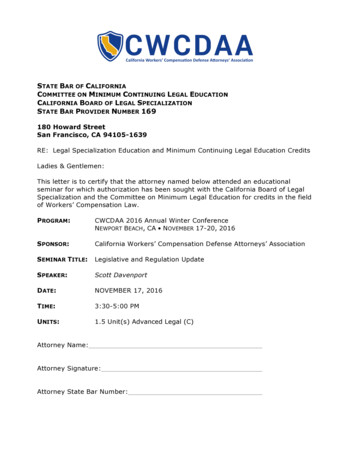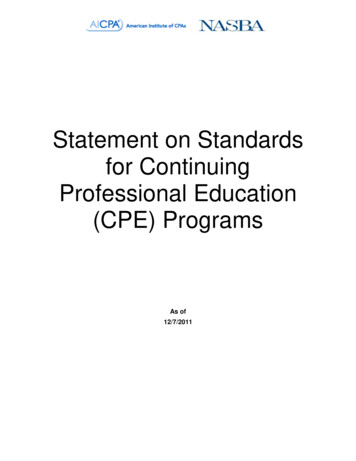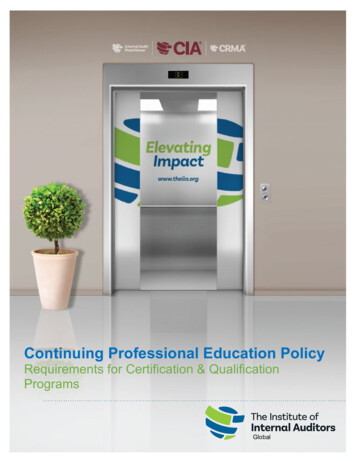
Transcription
Continuing Professional Education PolicyRequirements for Certification & QualificationProgramsGlobal
Contents1.Introduction .22.Annual Reporting Period .23.Annual Reporting Requirements .23.1. Annual CPE Hours .23.2. Ethics Training .33.3. Standards Conformance .33.4. Code of Ethics Attestation .43.5. Hardship Exemptions .44.Qualifying CPE Activities.44.1. Educational Programs .44.1.1. MEASURING CPE HOURS .54.1.2. Education Subject Areas .54.2. Other Qualifying Activities .54.2.1. PASSING EXAMINATIONS .54.2.2. AUTHORING OR CONTRIBUTING TO PUBLICATIONS.54.2.3. Translating Publications .64.2.4. Delivering Oral Presentations .64.2.5. Participating as a Subject Matter Expert Volunteer .74.2.6. Performing External Quality Assessments .75.CPE Reporting Process .85.1. CPE Reporting Fee.85.2. Annual Reporting Deadline .85.3. Failure to Earn or Report CPE Hours .85.1. CPE Audit .96.Maintaining CPE Records .91
1. IntroductionThe business world faces ongoing changes and emerging risks that impact how internal auditors meet theirorganizations’ needs. As such, the knowledge and skills internal auditors need to possess to provide professionalassurance and consulting services continually evolves. The International Standards for the Practice of Internal Auditing(Standards) require internal auditors to enhance their knowledge, skills, and other competencies through continuingprofessional development. This requirement helps ensure that internal auditors remain competent in the growing anddynamic profession of internal auditing.Moreover, those who have obtained a professional certification/qualification through The IIA (henceforth referred toas “certified individuals”) are required to obtain continuing professional development. This document outlines thecontinuing professional education (CPE) requirements for the following IIA certifications and qualifications and specifiesthe CPE reporting process for certified individuals who wish to keep their certifications in good standing: Certified Internal Auditor (CIA ). Certification in Control Self-Assessment (CCSA ). Certified Government Auditing Professional (CGAP ). Certified Financial Services Auditor (CFSA ). Certification in Risk Management Assurance (CRMA ). Qualification in Internal Audit Leadership (QIAL ).2. Annual Reporting PeriodThe annual reporting period begins 1 January and ends 31 December each year. CPE reporting must be completed viaCCMS by 31 December annually.For newly certified individuals, the initial reporting period begins on the date of certification and ends 31 December ofthe following year. (For example, an individual who obtains a new certification 20 February 2022 may begin earningCPE in 2022 but does not need to report CPE until 31 December 2023.)3. Annual Reporting RequirementsThe IIA requires certified individuals to self-attest annually that they have met the CPE requirements outlined in thisdocument. Annual reporting requirements vary depending on whether the certified individual is practicing (activelyperforming internal audit or related activities), nonpracticing (not actively performing internal audit or relatedactivities), or retired (no longer in the workforce). Retired professionals are exempt from all reporting requirementsfor as long as they remain retired. It is the certified individual’s responsibility to notify The IIA when he or she hasretired, by submitting a support case through the Certification Candidate Management System (CCMS) requesting astatus change.To maintain an active IIA certification/qualification, both practicing and nonpracticing certified individuals are requiredto: Obtain and attest to the completion of the required CPE credit hours annually. (Specific requirements varydepending on which certification/qualification they hold and whether they are practicing or nonpracticing.) Obtain and attest to at least two hours of ethics training annually. Indicate whether they conform with the Standards. Abide by and attest to their conformance with The IIA’s Code of Ethics.Details regarding each of these requirements, as well as hardship exemptions, can be found in the sections below.3.1. Annual CPE HoursThe number of annual CPE hours required varies depending on the certification/qualification held and whether thecertified individual is practicing or nonpracticing, as outlined in the following chart.2
Reporting StatusPracticingNonpracticingDefinitionUse Certification/ QualificationCPE Hours for CIACPE Hours for CCSA,CGAP, CFSA, CRMA,QIALActively performinginternalaudit or relatedactivitiesNot activelyperforming internalaudit or relatedactivitiesYes4020Yes2010For individuals who hold multiple certifications/qualifications, the CPE hours earned for the CCSA, CGAP, CFSA, CRMA,and QIAL may be applied toward their required CPE hours for the CIA. In other words, if a practicing individual holdsboth the CIA and CRMA, and completes 40 hours of training related to internal auditing and risk managementassurance, those hours can be used to satisfy the CPE requirements for both the CIA and CRMA.More information regarding educational program criteria, how CPE hours are measured, acceptable curriculum, andother activities for which certified individuals can earn CPE hours are provided in the section below on Qualifying CPEActivities.3.2. Ethics TrainingCertified individuals are required to complete two CPE hours focused on the subject of ethics. Ethics training hoursmay be applied toward the individual’s total annual CPE requirement. The IIA does not prescribe where an individualmust obtain this training. However, the training must occur annually, within the reporting period.3.3. Standards ConformanceThe Professional Certifications Board (PCB) requires that certified individuals recognize and understand the MandatoryGuidance component of The IIA’s International Professional Practices Framework (IPPF), including the Standards. TheIIA encourages certified individuals to obtain training related to the Standards if possible. At minimum, certifiedindividuals must review the Standards annually, determine whether they perform internal audit services in accordancewith the Standards, and report their conformance or nonconformance to The IIA. (Nonconformance with theStandards does not inactivate or otherwise negatively impact the individual’s certification status.)3
3.4. Code of Ethics AttestationCertified individuals must abide by The IIA’s Code of Ethics and report any criminal convictions. Specifically, they mustannually attest to the following: I will abide by The IIA Code of Ethics. I will not bring The IIA into disrepute, or in any way discredit the organization. I have completed the recommended two hours of training in the subject of ethics. I confirm that I have had no criminal convictions since the prior reporting period. (Certified individuals arealso required to state the details of any criminal conviction they have had since their prior reporting period.)3.5. Hardship ExemptionsThe PCB, upon request, may grant partial or complete exemption from reporting requirements for certified individualswhen good cause exists, such as military service or individual hardship. Supporting documentation is required before ahardship case will be reviewed. Certified individuals requesting an exemption should log an incident in their CCMSrecord prior to the CPE reporting deadline. Individuals may access the CCMS via The IIA’s website:https://ccms.theiia.org/4. Qualifying CPE ActivitiesThe IIA expects certified individuals to maintain the high standards of the internal audit profession when selectingquality educational programs to fulfill their CPE requirements. It is the certified individual’s responsibility to ensurethat their CPE hours conform to the guidelines established by the PCB.4.1. Educational ProgramsOne of the most common ways certified individuals earn CPE hours is by completing educational programs. In fact,certified individuals may earn all of their required annual CPE hours by attending such programs. Therefore, the PCBhas established criteria to ensure that educational programs maintain a high standard of quality. For a CPE program tobe deemed acceptable by the PCB, it must meet all of the following criteria: Be a formal program of learning that contributes directly to the professional competence of the certifiedindividual. Clearly state program objectives, which specify the level of knowledge the participants should have attained,or the level of competence to be demonstrated upon completion of the program. Clearly state education or experience prerequisites, if appropriate for the program. Be developed by individuals who are qualified in the subject matter and instructional design. Provide current program content. Provide evidence of program completion or participation and the appropriate number of CPE hours earned(e.g., a certificate of completion).The PCB recognizes the following professional education and development programs as meeting the aforementionedcriteria: Seminars and conferences provided by national, state, or local auditing or accounting organizations. Technical sessions at meetings of national/federal, state, or local auditing or accounting organizations andchapters (e.g., training provided during an IIA chapter meeting). Formal in-house training programs that meet the aforementioned educational program requirements. Relevant industry-specific educational programs provided by other professional organizations or societies. College or university courses passed (credit and noncredit courses), excluding courses that a candidate musttake to meet the examination requirement for a bachelor's degree or its equivalent. Formal correspondence and self-study programs relevant to internal auditing that meet program criteria,including evidence of completion.4
4.1.1. MEASURING CPE HOURSCPE program participation is measured by actual program length, with one 50-minute period equal to one CPE hour. Ifa program is fewer than 50 minutes, participants may earn and report CPE in 10- or 25-minute increments. For CPEactivities where segments are less than 50 minutes, the sum of the segments can be considered one total program.For example, five 25-minute training course segments would equal 125 minutes and should be counted as 2.5 CPEhours.4.1.2. Education Subject AreasCertified individuals should seek CPE programs that meet the aforementioned criteria and offer curricula related tothe subject areas covered by the certification(s)/qualification that the certified individual holds.In general, the subject areas included in the current certification exam syllabi are acceptable. Certified individuals areencouraged to refer to the following exam syllabi to identify relevant subject areas in which they should pursuecontinuing education:Certification /QualificationCIACCSACGAPCFSACRMAQIALExam 4.2. Other Qualifying ActivitiesIn addition to formal educational programs, certified individuals may obtain CPE through a variety of other qualifyingactivities*, including: Passing examinations. Authoring or contributing to publications. Translating publications. Delivering oral presentations. Participating as a subject matter expert volunteer. Performing external quality assessments.Details regarding how many CPE can be earned for each activity are provided in the sections below.*Note: Activities other than those listed in this policy document may be deemed acceptable if the certified individual isable to evidence the activity, calculate an appropriate number of CPE hours, and demonstrate that it contributes toprofessional competence. It is the responsibility of the certified individual to substantiate that a particular activityqualifies as acceptable and meets the PCB’s requirements.4.2.1. PASSING EXAMINATIONSPassing non-IIA certification examsCPE hours awarded for passing each part of an accounting or auditing exam(e.g., CPA or CA)10Total maximum CPE hours awarded in the year that the exam was passed404.2.2. AUTHORING OR CONTRIBUTING TO PUBLICATIONSCertified individuals who author or contribute to publications may obtain CPE hours for their work, as long as theircontributions pertain to relevant subject areas such as the common body of knowledge for the global internal auditprofession or techniques in their area of specialization. For CPE earning and reporting purposes, “publications” isdivided into four categories. There is a limit on the number of CPE hours that can be reported for each category, aswell as a limit on the total number of CPE hours that can be reported for publications.5
Publication CategoriesMaximum CPE hours permittedfor each categoryCIA1.Authoring or contributing to books(1 CPE hour per 200 words)25CCSA, CGAP, CFSA,CRMA, QIAL102.Authoring or contributing to research papers, articles, or blogs(1 CPE hour per 200 words)1563.Authoring IIA certification exam questions(1 CPE hour per accepted exam question)20104.Authoring a QIAL case study(10 CPE hours per accepted QIAL case study)20102510Total maximum CPE hours permitted for authoring or contributingto publications4.2.3. Translating PublicationsTranslations of publications should pertain to certification domains or disciplines related to the common body ofknowledge for the global internal audit profession or techniques in their area of specialization. Translations ofpublished articles or books not related directly to internal auditing are acceptable if the certified individual is able todemonstrate that these activities contribute to their professional audit proficiency. For CPE earning and reportingpurposes, “translations” are divided into two categories. There is a limit on the number of CPE hours that can bereported for each category, as well as a limit on the total number of CPE hours that can be reported for translatingpublications.Maximum CPE hours permittedTranslation Categoriesfor each categoryCIA1.Translating books(1 CPE hour per 200 words)25CCSA, CGAP, CFSA,CRMA, QIAL102.Translating IIA Supplemental Guidance (e.g., Practice Guides,GTAGs, etc.), research papers, articles, or blogs(1 CPE hour per 200 words)156Total maximum CPE hours permitted for translating publications25104.2.4. Delivering Oral PresentationsCertified individuals who deliver oral presentations (e.g., seminars, conferences, or in-house training) may obtain CPEhours for their effort, as long as their contributions pertain to relevant subject areas such as the common body ofknowledge for the global internal audit profession or techniques in their area of specialization. Certified individualsmay earn one CPE hour for each 50 minutes of presentation time, plus credit for preparation time, equivalent to threetimes the presentation time. For example, for delivering a 50-minute presentation, a certified individual would earn 4CPE hours (1 CPE hour for the presentation itself, and 3 CPE hours for preparation). Subsequent presentations of thesame material may be reported as presentation time only.6
Original Vs. Subsequent PresentationsMaximum CPE hours permittedfor each categoryCIAOriginal presentations(CPE is calculated based on presentation time plus preparation time)25CCSA, CGAP, CFSA,CRMA, QIAL10Subsequent presentations of the same material(CPE is calculated based on presentation time only)52Total maximum CPE hours permitted for delivering oralpresentations25104.2.5. Participating as a Subject Matter Expert VolunteerCertified individuals may earn CPE hours for a variety of activities under the “Participation” category, including servingas a committee member, QIAL assessor or panelist, IIA Global Guidance Contributor, or exam content translationquality reviewer. For CPE earning and reporting purposes, “participation” is divided into four categories. There is alimit on the number of CPE hours that can be reported for each category, as well as a limit on the total number of CPEhours that can be reported for translating publications.Maximum CPE hours permittedParticipation Categoriesfor each categoryCIAServing as a volunteer officer or committee member with TheIIA or another professional industry organization related tointernal auditing(1 CPE hour for each 50 minutes of qualifying participation)IIA global guidance contributor(5 CPE hours per IPPF Supplemental Guidance)15CCSA, CGAP, CFSA,CRMA, QIAL101053.Exam content quality review(1 CPE hour per 50-minute period of work)20104.QIAL volunteer:Portfolio of professional experience (PPE) assessor(½ CPE hour per PPE unit)Case study grader(½ CPE hour per case study)20102010-QIAL panel assessor(1 CPE hour per presentation 1 CPE per interview)2010Total maximum CPE hours permitted for participating as a subjectmatter expert volunteer20101.2.4.2.6. Performing External Quality AssessmentsCertified individuals may earn CPE hours for their involvement in external quality assurance reviews. CPE hours areearned for onsite time only; no CPE hours will be awarded for activities such as making advanced preparations for thereview or writing the report. There is a limit on the number of CPE hours that can be reported for each type ofassessment, as well as a limit on the total number of CPE hours that can be reported for external quality assessments7
.Quality Assessment CategoriesMaximum CPE hours permittedfor each categoryCIA1.Independent (external) validation of an internal audit activity’sself-assessment, as defined by the IPPF5CCSA, CGAP, CFSA,CRMA, QIAL52.One-week external quality assessment1053.Two-week external quality assessment20102010Total maximum CPE hours permitted for performing externalquality assessments5. CPE Reporting ProcessEach year, certified individuals (both practicing and nonpracticing) receive a notification from The IIA reminding themof their annual obligation to report CPE hours. Certified individuals report their CPE hours by submitting a CPEreporting form annually, which serves as a signed statement that all applicable CPE requirements have been met. Aseparate CPE reporting form is required for each certification held. Supporting documentation (e.g., certificate oftraining completion) should not be submitted at this time. Individuals may submit CPE reporting forms through theCCMS or through their local Affiliate, as appropriate. It is the certified individual’s responsibility to ensure that the CPEhours are reported appropriately. In addition to reporting their completion of the required CPE hours, as statedearlier, certified individuals must indicate whether they conform with the Standards and attest to their conformancewith The IIA’s Code of Ethics.5.1. CPE Reporting FeeCPE reporting fees vary according to membership status, certification(s) held, and the location of the certifiedindividual. For the most current information regarding CPE reporting fees, visit:North America – www.theiia.org/CertificationOutside North America – www.globaliia.org/Certification5.2. Annual Reporting DeadlineReporting for the current year must be completed by 31 December each year. The IIA will issue an acknowledgment ofcompliance to each individual who has successfully met the requirements outlined in this document.5.3. Failure to Earn or Report CPE HoursCertified individuals who fail to obtain enough hours in the calendar year should not submit a CPE reporting form.Only when the individual has earned enough hours should the CPE reporting be completed.Individuals who do not complete their CPE reporting on or before 31 December will automatically transition fromcertified to Grace Period status. Individuals who remain in a Grace Period status for more than 12 months willautomatically be transitioned to Expired status. Additional details regarding each of these CPE reporting statuses ― andhow to revert back to an Active status ― are provided below.Grace Period Status - Individuals who are moved into this status will receive notification of the statuschange either directly from the CCMS or their local Affiliate. Individuals with Grace Period status may notclaim that they are Active. To change a status from Grace Period back to an Active status, the individual mustcomplete the prior year’s CPE reporting for each certification or qualification held with Grace Period status.Those who did not earn enough CPE hours during the reporting period may use hours from the next calendaryear to make up the deficiency. However, CPE hours used for moving back to an Active status may not beused toward the current year’s reporting requirements.Expired Status - Individuals who are moved into this status will receive notification of the status changeeither directly from the CCMS or their local Affiliate. Individuals with an Expired status may not claim thatthey are Active. To change a status from Expired back to an Active status, the individual must meet the CPE8
requirements for one reporting period, complete a reinstatement application for each certification orqualification held with an Expired status, and pay a reinstatement application fee (current rates are availableon The IIA’s global website: rtification/eligibility-pricing/.The CPE hours used for reinstatement may not be used toward the current year’s reporting requirements.5.1. CPE AuditAnnually, The IIA (or its designee) will conduct an audit of CPE reporting records. Individuals selected for the audit arerequired to provide evidence/documentation of the CPE hours they earned. Individuals who fail to provide informationby the stated deadline will automatically be moved to an inactive (grace period) status and may no longer claim thatthey are certified. If the CPE audit reveals that an individual has insufficient CPE hours, the individual will be granted asix-month period to earn deficient CPE hours and submit documentation of hours earned to IIA Global. Individuals whoare found to falsify documentation or act in an unethical manner will be reported to the Professional Responsibility andEthics Committee for further investigation.6. Maintaining CPE RecordsAs stated earlier, the supporting documentation (such as certificates of training completion that an individual mayuse to calculate the number of CPE hours earned) should not be submitted with the annual CPE reporting form.However, certified individuals must maintain a copy of all supporting documentation as well as the CPE reportingform(s) they submitted for at least three years, and records must be made available to The IIA or its designee upon TheIIA's request. The records maintained by the individual must include the following information, as appropriate:Title of program and/or description of content.Dates attended.Location of course or program.Sponsoring organization.Contact CPE hours of credit, as recommended by the course or program sponsor.A letter, certificate, or other written independent attestation of course completion.Documentation supporting publications, oral presentations, committee involvement, or other participation.9
2022 – February10
CPE program participation is measured by actual program length, with one 50-minute period equal to one CPE hour. If a program is fewer than 50 minutes, participants may earn and report CPE in 10- or 25-minute increments. For CPE activities where segments are less than 50 minutes, the sum of the segments can be considered one total program.



